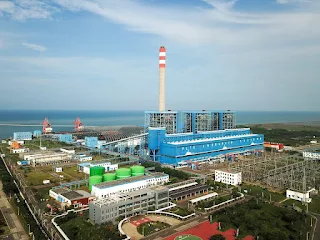- Investment Value: IDR 30
Trillion
- Funding Scheme: BUMN
Assignment
- Location: Kuala Tanjung,
North Sumatra
- Project Responsible:
Ministry of Transportation
- Planned Construction
Commencement: 2015
- Planned Operation
Commencement: 2018
- Project Status:
Partially Operating
Project Description
Development of the port
in Kuala Tanjung into an international hub port as an entry point to the
western region of Indonesia. Based on the results of a study conducted by the
Ministry of Transportation in 2015, the development of the port will increase
the volume of container traffic to 12.4 million TEUs by 2039.
This increase in
container traffic volume comes from demand from the Sei Mangkei Special
Economic Zone (KEK) to Jambi Province and it is assumed that the port will
receive additional demand from four competitor ports, namely the Port of
Singapore, Port of Tanjung Pelepas, Port Klang and Penang Port.
Project Significance
With an international
hub, it is hoped that Indonesia can enjoy the port demand that has been enjoyed
by Singapore and Malaysia. Based on the 2012 Kuala Tanjung Port Plan, the
construction of this port will accommodate cargo to support the development of
the Sei Mangkei Special Economic Zone (KEK) and Belawan Port.
Project Development
Status: PARTIALLY OPERATING
KUALA TANJUNG PORT
PREPARED TO BECOME INDONESIA'S TRANSSHIPMENT PORT
JAKARTA (27/9). The
government continues to encourage the development of infrastructure that can
boost the Indonesian economy, including port infrastructure. One of them is
Kuala Tanjung Port located in North Sumatra Province.
Director General
(Dirjen) of Sea Transportation, Arif Toha explained that the port located in
Batu Bara Regency is prepared to become a transshipment port, which can be
visited by large ships from a number of countries.
A transshipment port is
an export hub port, where cargo from small ships all over the world is
transferred to large ships docked at the port to be sent abroad and vice versa.
"Kuala Tanjung Port
uses the concept of a self-generating port, namely that port cargo is obtained
from the port area itself. Cargo will be generated by industries located in the
industrial area integrated with Kuala Tanjung Port," said Director General
Arif.
Kuala Tanjung Port is
managed by KSOP Class III Kuala Tanjung as the organizer and PT Pelabuhan
Indonesia (Persero) as the operator.
Kuala Tanjung Port has
several advantages, including being located in a strategic location in the
Strait of Malacca, which is one of the main trade routes in the world. Kuala
Tanjung will be connected by the Trans Sumatra toll road which is currently
under construction. And there is a railway line so that it will facilitate connectivity
from and to the port.
"Kuala Tanjung Port
is projected to take part of the transshipment market in the Strait of Malacca,
with a market share of 5%," said Director General Arif.
"There will be a
collaboration with Belawan Port which will become a Container Consolidator in
the Hinterland of Northern Sumatra (Medan, Aceh, North Tapanuli), while Kuala
Tanjung will become a Logistic and Supply Chain Hub in Indonesia," said
Director General Arif.
The development of Kuala
Tanjung is carried out in stages, starting with the construction of a Multi
Purpose Terminal that functions as the North Sumatra Gateway, followed by the
development of an industrial area that will generate cargo for the Multi
Purpose Terminal, so that an optimal cargo volume is created as the basis for
developing the Hub Port.
The first stage of the
Kuala Tanjung Port Development, namely the Kuala Tanjung Multipurpose Terminal,
has been operational. The port managed by Pelindo is equipped with a 500x60 m
pier, a 2.8 km long trestle for four 18.5 m wide truck lanes.
Kuala Tanjung Port is
currently equipped with complete and modern port facilities supported by an
integrated IT system so that it can improve services to service users and
increase the speed of the loading and unloading process.
Supporting the Sei
Mangkei Special Economic Zone
Currently, there is the
Sei Mangkei Special Economic Zone and other industrial areas operating in North
Sumatra Province and surrounding provinces adjacent to Kuala Tanjung Port. It
is hoped that the industrial area will use Kuala Tanjung Port as a distribution
center for goods in supporting the role of Kuala Tanjung Port as an
international hub.
"One of the
requirements for economic progress in a region is smooth logistics, and the
existence of Kuala Tanjung Port can support smooth logistics distribution in
the Sei Mangkei Special Economic Zone," said Director General Arif.
The existence of Kuala
Tanjung Port can increase productivity in the North Sumatra region which has
many potential Natural Resources (SDA), including palm oil, CPO derivative
products, rubber, paper, and others.
"In addition,
several industrial companies such as Inalum are planned to open branches in the
area, so that with this large port it can support the mobility of goods from
and to the Sei Mangkei Special Economic Zone," he explained.
Several large companies
operating around Kuala Tanjung Port are PT Indonesia Asahan Alumunium, PT
Multimas Nabati Asahan (Wilmar), PT Domas Argointi Prima, PT Industri Nabati
Lestari, PT Unilever Oleochemical Indonesia, PT Sumatra Tobacco Trading
Company, PT Toba Pulp Lestari and other companies that have the potential to
enter the area.
"So the existence
of Kuala Tanjung Port is expected to be an attraction and encourage the
realization of industrial progress," concluded Director General Arif.
Source:
Project Information:



















